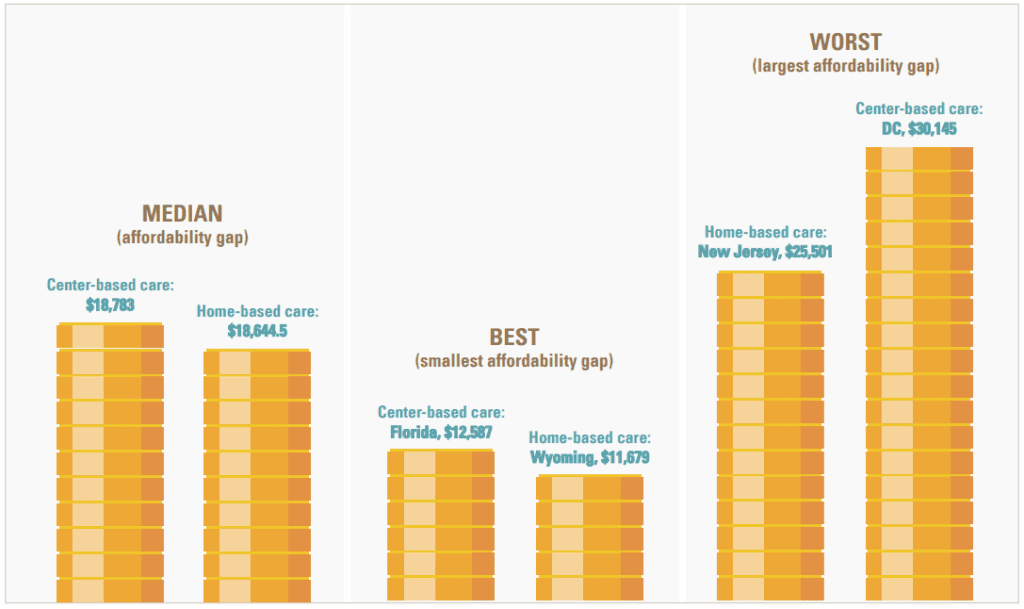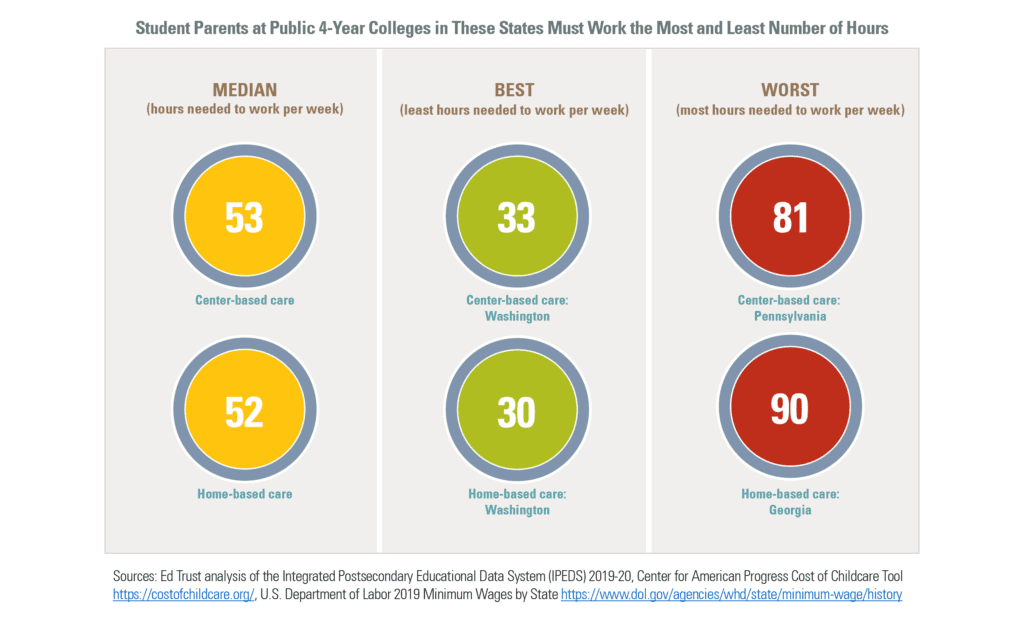For Student Parents, The Biggest Hurdles to A Higher Education are Costs and Finding Child Care
It's hard to be a student parent. College students who are parenting must juggle work and family responsibilities while…

It’s hard to be a student parent. College students who are parenting must juggle work and family responsibilities while going to school and often struggle to find child care. It’s also expensive. The costs of child care, tuition, books, and attending to basic needs — not to mention one’s own physical and mental well-being — can quickly add up. Child care and college tuition costs alone can be insurmountable obstacles for those who are only trying to make a better life for themselves and their little ones.
In 2019, The Education Trust released a report — “How Affordable Are Public Colleges in Your State for Low-Income Students?” — that dispelled the myth that a student can still work their way through college in a minimum-wage job.
In continuation of this affordability work — with support from Imaginable Futures and in partnership with Generation Hope — we conduct a similar analysis, this time for student parents. In this latest report, we tally the cost of child care and the price of attending a public four-year college — including tuition and fees, housing, food, books, and transportation — to determine a student parent’s actual annual cost of pursuing a degree.
The Student Parent Affordability Gap is the average amount that a student parent from a low-income background would pay annually to pursue a degree at a two- or –four-year public college in each state plus the average costs of child care minus grants, scholarships, and earnings from working 10 hours per week at the state minimum wage.
Campus leaders, and federal and state policymakers must do more to support student parents, who are disproportionately single, students of color, and from low-income backgrounds. These students are often juggling work, school, and family responsibilities, and may be struggling to find child care and meet basic needs, especially amid the on-going pandemic and current period of high inflation. Student parents are working hard and making sacrifices to secure a better future for themselves and their children. Surely, we can make it easier for them to succeed.
Our recommendations attempt to address the needs of the whole student parent and their children, while advocating for more affordable child care and access to supports that would indirectly reduce the student parent affordability gap.
Student parents face many barriers to completing a postsecondary degree, but financial hurdles are usually the biggest impediment. According to data gathered by the Department of Education in 2021, college costs have risen by 28% at public institutions and 19% at private nonprofit institutions since 2008, making a higher education less accessible for many students, particularly student parents.
While college costs have risen nationally, student parents have been hit particularly hard by tuition increases. According to recent research by California Competes on the net price of college, on average, student parents pay $7,592 per child in additional costs out of pocket annually than their counterparts without children.
Considering that two-thirds of student-parents (68%) live at or near the poverty line, it is unsurprising that these extra costs would make it hard for student-parents to afford a degree.
Student parents can apply for financial assistance using the FAFSA but the financial aid system and many college financial aid offices often fail to consider the unique financial plight of these students. As a result, many student parents wind up with ballooning student debt.
Child care is critical for many student parents but the limited availability of on-campus child care services, in tandem with long waitlists, often makes it inaccessible. In 2015, 49% of four-year public colleges provided on-campus services, down from 55% in 2003.
Moreover, institutions that offer on-campus child care may not have enough slots to go around. Programs often have long waitlists, and few offer extended or evening hours, forcing many student parents to rely on a patchwork system of care. In some rural areas, there aren’t enough children to sustain a child care center, making home-based child care the only available option. And in some states, home-based child care costs more than center-based care, putting an added financial strain on the families living there.
Regardless of the type of child care arrangement few low-income families can afford the full cost on their own, even before higher education costs are added on.
Student parents often have no choice but to turn to inconvenient and more costly alternatives, given the lack of available child care on college campuses. While child care costs between $7,000 – $8,800 per year, on average, depending on the age of the child, child care subsidies for low-income parents are about $4,600 per year, leaving student parents to fill the gap.
The bottom line is that many student parents from low-income backgrounds must come up with thousands of dollars, and in some cases, tens of thousands of dollars — after grants, scholarships, and earnings from working 10 hours per week — to cover the full cost of attending a public college in nearly every state. We call this the “student parent affordability gap.”
According to the most recent data on college affordability, wages, and child care costs, there is no state in which a student parent can work 10 hours a week at the minimum wage and afford both tuition and child care at a public college or university.
In fact, many states that look affordable based on their reported net price actually have a wider affordability gap for student parents. When you factor in child care, the out-of-pocket cost of attending a public college often becomes 2 to 5 times higher.
We know that there is no state where a student parent can work 10 hours per week at the minimum wage and afford both tuition and child care, but how many hours would a student parent have to work to cover those costs?
Our analysis shows that a student parent would need to work anywhere from 30 to 90 hours per week, on average, to cover child care and tuition costs at a public college or university in the U.S.
Because many student parents working toward a degree need child care net price alone is not a good indicator of college affordability for student parents; the number of hours a student parent must work to afford college and child care will also depend on their state minimum wage. A student parent in a state with a high published net price, high child care costs, and a high minimum wage may, in fact, need to work fewer hours than a student parent living in a state with a low minimum wage.


Continue Exploring the Findings for the Nation and Your State